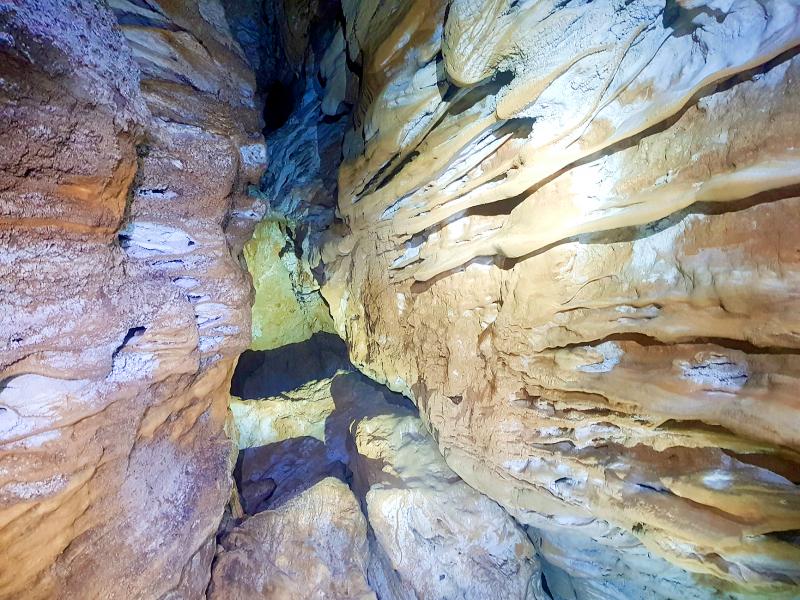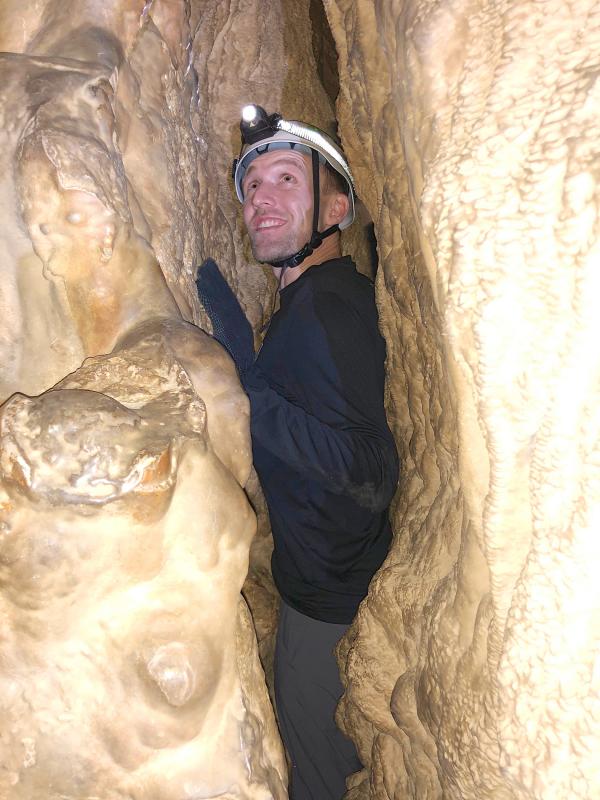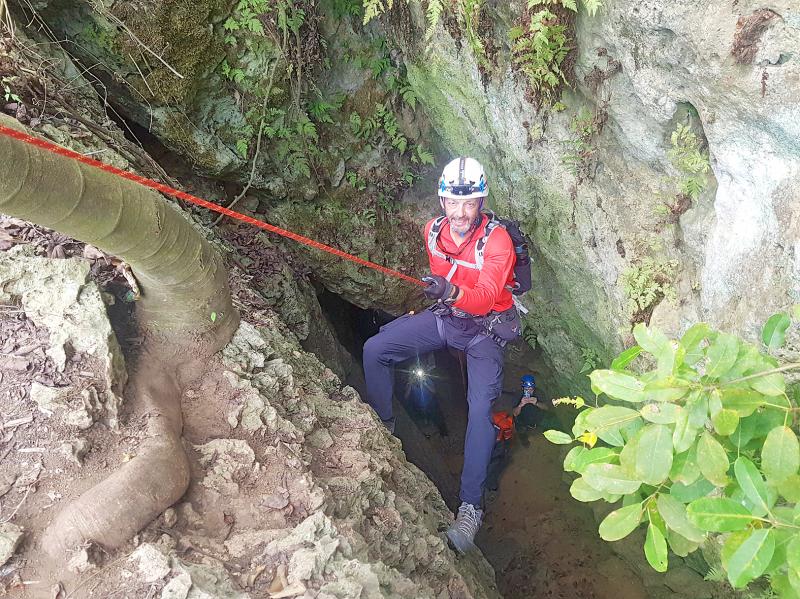Over a million years in the making, the outdoor playground that is Kaohsiung’s Shoushan (壽山), commonly known as “Monkey Mountain,” is a rich geological and ecological resource that visitors to the city should be sure not to miss. Many are familiar with the area’s hiking trails and resident monkey population, but even locals may be surprised to learn of the extensive system of caves here, full of classic examples of speleothems like stalactites, stalagmites, draperies and flowstones, as well as cave-dwelling fauna.
These caves are the result of hundreds of thousands of years of erosion slowly dissolving the mountain’s limestone. There are hundreds of such cavities, some extending dozens of meters into the mountain. To this day, no complete survey has ever been done. The stone itself was laid down by corals in nascent Taiwan’s shallow coastal waters over a million years ago, before being driven upwards by tectonic action. Indeed, marine fossils are common all over the mountain.
NATIONAL PARK

Photo: Tyler Cottenie
In 2011, Monkey Mountain, along with a few other nearby hills, became protected as Shoushan National Nature Park. With the establishment of the Park, the “Wild West” days of Monkey Mountain came to an end, and the vast system of limestone caves on the mountain, formerly a spelunking free-for-all, became mostly off limits.
Currently, public access is officially limited to four caves, only between the months of November and April, and only when accompanied by a park-certified guide (details below). The other hundred-odd caves are not gated in any way to prevent access, but according to the law such access is now forbidden. Our group was led through all four caves last month by cave guide Chin Nan.
WALKING UNDERGROUND

Photo: Tyler Cottenie
Our first stop was Orangutan Cave (猩猩洞), named after several ape-shaped rocks found inside. The high ceiling and flat floor make this the safest and easiest of the four caves to explore. For those who are looking for more of a challenge — and are of slim build — there is, however, a narrow passageway that one can attempt to squeeze through.
At our guide’s encouragement, I attempted this, and without his further encouragement toward the end, I would not have gotten through. I started crawling along the floor under a ceiling that got progressively lower, until the only way forward was by sliding on my back, inching forward as the weight of tons of limestone hung just above my nose. At last I reached a wall and a narrow vertical space in which I could stand up.
Passing through this space and back out to the main cave chamber just a meter or two away still took several minutes. The space was so narrow that I had to pass my helmet out to the guide first so that my head could fit. The subsequent contortions required to step up, over and out made me regret not taking yoga classes in preparation for this trip. I wouldn’t have even believed it possible were it not for the guide’s insistence that others had made it through. Only one other person in the group attempted the passage but he was not successful. The rest of the group thoroughly enjoyed the experience of watching our attempts — the entertainment value of watching a friend struggling to squeeze through a narrow gap cannot be overstated.

Photo courtesy of Brett Gentle
Next on the agenda was Tianyutiancai Cave (天雨天財洞), literally “Sky Rain Sky Fortune Cave.” It is the most visited and photographed cave on the mountain and derives its name from the hole in the ceiling near the entrance that allows rain to fall into the cave (Sky Rain) and the hole in the ceiling at the far end of the cave, whose shape resembles either an old Chinese cash coin or a sycee (Sky Fortune).
The latter location attracts the Instagram crowd, as sunlight streaming through this hole under just the right conditions creates a sort of heavenly light illuminating those standing below. If conditions aren’t just right for this photo, this cave still has plenty to offer. We found the molted exoskeleton of a Macrothele spider and a collection of snail shells, some of which were so old they were already being incorporated into the limestone on the cave floor. In addition, the beautiful flowstone on the walls here can be seen all at once thanks to the natural lighting provided by the “Sky Fortune” hole.
CRAWLING AND CLIMBING

Photo: Tyler Cottenie
After a lunch break, we continued on to the third cave of the day, Beifong Jile Cave (北峰極樂洞), literally “North Peak Bliss Cave.” This was the highlight of the day for most of us, as our guide set up ropes, allowing us to enter the cave by rappelling down a vertical wall and to exit the cave on the other end with a belayed rope climb.
Fortunately, Chin Nan is a rock-climbing instructor by profession and was able to set this up for us; not every caving guide has this expertise. The interior of this cave was arguably the most impressive as well, with quartz deposits glittering like a thousand diamonds, massive limestone draperies protruding from the walls under a ceiling at least fifteen meters high and cave crickets on the rocks below silently observing the passage of yet another group of curious humans. This is the underground cathedral that comes to mind when one thinks of caving.
On our way to the last cave, we passed a group of locals out climbing on a perfect vertical face of limestone. The location looked ideal for the sport, but as it was not the park-designated climbing wall, they were risking a NT$3,000 fine.

Photo courtesy of Brett Gentle
Rock climbing on Monkey Mountain, as with caving, is officially limited to designated sites only. Near this climbing wall, our guide took us along an exciting footpath (permit not required) called the Little Zhuilu, named after the Zhuilu Trail (錐麓古道) in Hualien’s Taroko National Park. Like its namesake, this path is a narrow walkable strip perched halfway up a cliff, and like its namesake, it is not for acrophobes, though there are some ropes in place for safety.
After Little Zhuilu, we arrived at the entrance to the final cave of the day, Jingua Cave (金瓜洞), literally “Pumpkin Cave,” named after a giant symmetrical flowstone inside which looks remarkably like an inverted pumpkin. The highlight of this cave turned out not to be its namesake stone, but the animal life we encountered. There was another cave cricket, a huntsman spider and a solitary bat hanging from the ceiling who was not at all camera shy. The exit from this cave is a narrow hole just wide enough for one person to crawl up and out: a fitting end to a day of walking, rappelling, climbing and crawling our way through the limestone underbelly of Monkey Mountain.

Photo: Tyler Cottenie

Photo: Tyler Cottenie

Photo: Tyler Cottenie

Photo: Tyler Cottenie

US President Donald Trump may have hoped for an impromptu talk with his old friend Kim Jong-un during a recent trip to Asia, but analysts say the increasingly emboldened North Korean despot had few good reasons to join the photo-op. Trump sent repeated overtures to Kim during his barnstorming tour of Asia, saying he was “100 percent” open to a meeting and even bucking decades of US policy by conceding that North Korea was “sort of a nuclear power.” But Pyongyang kept mum on the invitation, instead firing off missiles and sending its foreign minister to Russia and Belarus, with whom it

When Taiwan was battered by storms this summer, the only crumb of comfort I could take was knowing that some advice I’d drafted several weeks earlier had been correct. Regarding the Southern Cross-Island Highway (南橫公路), a spectacular high-elevation route connecting Taiwan’s southwest with the country’s southeast, I’d written: “The precarious existence of this road cannot be overstated; those hoping to drive or ride all the way across should have a backup plan.” As this article was going to press, the middle section of the highway, between Meishankou (梅山口) in Kaohsiung and Siangyang (向陽) in Taitung County, was still closed to outsiders

President William Lai (賴清德) has championed Taiwan as an “AI Island” — an artificial intelligence (AI) hub powering the global tech economy. But without major shifts in talent, funding and strategic direction, this vision risks becoming a static fortress: indispensable, yet immobile and vulnerable. It’s time to reframe Taiwan’s ambition. Time to move from a resource-rich AI island to an AI Armada. Why change metaphors? Because choosing the right metaphor shapes both understanding and strategy. The “AI Island” frames our national ambition as a static fortress that, while valuable, is still vulnerable and reactive. Shifting our metaphor to an “AI Armada”

The Chinese Communist Party (CCP) has a dystopian, radical and dangerous conception of itself. Few are aware of this very fundamental difference between how they view power and how the rest of the world does. Even those of us who have lived in China sometimes fall back into the trap of viewing it through the lens of the power relationships common throughout the rest of the world, instead of understanding the CCP as it conceives of itself. Broadly speaking, the concepts of the people, race, culture, civilization, nation, government and religion are separate, though often overlapping and intertwined. A government